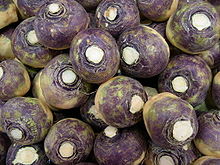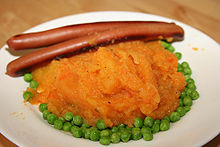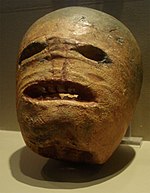Rutabaga
From Wikipedia, the free encyclopedia
For the Drosophila gene, see Rutabaga (gene). For similar vegetables also called "turnip", see Turnip (disambiguation).

| Rutabaga | |
|---|---|
| Scientific classification | |
| Kingdom: | Plantae |
| (unranked): | Angiosperms |
| (unranked): | Eudicots |
| (unranked): | Rosids |
| Order: | Brassicales |
| Family: | Brassicaceae |
| Genus: | Brassica |
| Species: | B. napobrassica |
| Binomial name | |
| Brassica napobrassica (L.) Mill. | |
The rutabaga, swede (from Swedish turnip),[1] turnip or yellow turnip (Brassica napobrassica, or Brassica napus var. napobrassica, or Brassica napus subsp. rapifera) is a root vegetable that originated as a cross between the cabbage and the turnip; see Triangle of U. The roots are prepared for food in a variety of ways, and its leaves can also be eaten as a leaf vegetable.
Etymology
Brassica napobrassica has many national and regional names used globally. Rutabaga is the common American and Canadian term for the plant. It comes from the old Swedish word Rotabagge, meaning simply "root ram". In the U.S., the plant is also known as Swedish turnip or yellow turnip. The term Swede is used instead of rutabaga in many Commonwealth Nations, including England, Wales, Australia, and New Zealand. The name turnip is also used in parts of Northern and Midland England, the Westcountry, particularly Cornwall, Ireland, Ontario and Atlantic Canada. In Scots, it is known as turnip, tumshie or neep (from Old English næp, Latin napus).[2] Some areas of south east Scotland, such as Berwickshire and Roxburghshire, still use the term baigie, possibly a derivative of the original Swedish rutabaga.[3] The term turnip is also utilized in southern English usage.[where?][2][4] Some will also refer to both types as just turnip (the word is also derived from næp).[who?][4] In North-East England, turnips and swedes are colloquially called snadgers, snaggers (archaic) or narkies.[citation needed]
Its common name in Sweden is kålrot (literally "cabbage/kale root"). Similarly, in Denmark it is known as kålroe, while in Norway it has usurped the name of kålrabi in addition to being known as kålrot. The Finnish term is lanttu. Rutabaga is known as Steckrübe in German.
[edit]History
The first known printed reference to the rutabaga comes from the Swiss botanist Gaspard Bauhin in 1620, where he notes that it was growing wild in Sweden. It is often considered to have originated from Scandinavia or Russia.[5] It is said to have been widely introduced to Britain around the end of the 18th century, but it was recorded as being present in the royal gardens in England as early as 1669 and was described in France in 1700. It was asserted by Sir John Sinclair in his Husbandry of Scotland to have been introduced to Scotland around 1781–1782. An article on the topic in The Gardeners' Chronicle suggests that the rutabaga was then introduced more widely to England in 1790. Introduction to North America came in the early 19th century with reports of planted rutabaga crops in Illinois as early as 1817.[6]
[edit]Botanical history
The species commonly known as swede or rutabaga has had a rich taxonomic history. The earliest account comes from the Swiss botanist Gaspard Bauhin, who wrote about it in his 1620 Prodromus.[6] Brassica napobrassica was first validly published by Carl Linnaeus in his 1753 work Species Plantarum as a variety of B. oleracea: B. oleracea var. napobrassica.[7] It has since been moved to other taxa as a variety, subspecies, or elevated to species rank. In 1768, a Scottish botanist elevated Linnaeus' variety to species rank as Brassica napobrassica in The Gardeners Dictionary, which is the currently accepted name.[8]
Rutabagas have a diploid chromosome number of 2n = 38. It originated from a cross between turnips (Brassica rapa) and Brassica oleracea. The resulting cross then doubled its chromosomes, becoming an allopolyploid species. This relationship was first published by Woo Jang-choon in 1935 and is known as the Triangle of U.[9]
[edit]Preparation and use
Finns cook rutabagas in a variety of ways: roasted (to be served with meat dishes), baked, boiled, as a major flavor enhancer in soups, uncooked and thinly julienned as a side dish or in a salad, and as the major ingredient in the ever popular Christmas dish Swede casserole (lanttulaatikko). Finns use rutabagas in most dishes that call for any root vegetable.
Swedes and Norwegians cook rutabagas with potatoes and sometimes carrots, and mash them with butterand either stock or, occasionally, milk or cream, to create a puree called rotmos (Swedish, literally: root mash) and kålrabistappe (Norwegian). Onion is occasionally added. In Norway, kålrabistappe is an obligatory accompaniment to many festive dishes, including smalahove, pinnekjøtt, raspeball and saltedherring. In Sweden, rotmos is often eaten together with cured and boiled ham hock, accompanied bymustard. This classic Swedish dish is called fläsklägg med rotmos. In Wales, a similar mash produced using just potatoes and rutabagas is known as ponch maip.
In Scotland, rutabagas and potatoes are boiled and mashed separately to produce "neeps and tatties" ("tatties" being the Scots word for potatoes), traditionally served with the Scottish national dish of haggis as the main course of a Burns supper. Neeps may also be mashed with potatoes to makeclapshot. Regional variations include the addition of onions to clapshot in Orkney. Neeps are also extensively used in soups and stews.
In England, they are regularly eaten mashed as part of the traditional Sunday roast. Often they are boiled together with carrots and served either mashed or pureed with butter and ground pepper. The highly flavored cooking water is often retained for soup, or as an addition to gravy. Rutabagas are an essential vegetable component of the traditional Welsh lamb broth called cawl.
In Canada, rutabagas are used as filler in foods such as mincemeat and Christmas cake, or as a side dish with Sunday dinner in Atlantic Canada. In Canada, they are often referred to as "turnips".
In the US, rutabagas are mostly eaten as part of stews or casseroles, served mashed with carrots, or baked in a pasty. They are frequently found in theNew England boiled dinner.
In Australia, rutabagas are used in casseroles, stews and soups as a major flavor enhancer.
Despite their popularity elsewhere, rutabagas are considered a food of last resort in Germany due to their association with food shortages in World War I and World War II. Boiled stew with rutabaga and water as the only ingredient (Steckrübeneintopf) was a typical food in Germany during the famines and food shortages of World War II, as well the following years. As a result, many older Germans don't have fond memories regarding this emergency food. Although the rutabaga is still eaten in parts of Northern Germany, most Germans prefer to use the related kohlrabi (German turnip) instead.
[edit]Phytochemistry
| Nutritional value per 100 g (3.5 oz) | |
|---|---|
| Energy | 157 kJ (38 kcal) |
| Carbohydrates | 8.62 g |
| - Sugars | 4.46 g |
| - Dietary fiber | 2.3 g |
| Fat | 0.16 g |
| Protein | 1.08 g |
| Thiamine (vit. B1) | 0.09 mg (8%) |
| Riboflavin (vit. B2) | 0.04 mg (3%) |
| Niacin (vit. B3) | 0.7 mg (5%) |
| Pantothenic acid (B5) | 0.16 mg (3%) |
| Vitamin B6 | 0.1 mg (8%) |
| Folate (vit. B9) | 21 μg (5%) |
| Vitamin C | 25 mg (30%) |
| Calcium | 43 mg (4%) |
| Iron | 0.44 mg (3%) |
| Magnesium | 20 mg (6%) |
| Manganese | 0.131 mg (6%) |
| Phosphorus | 53 mg (8%) |
| Potassium | 305 mg (6%) |
| Zinc | 0.24 mg (3%) |
| Link to USDA Database entry Percentages are relative to US recommendations for adults. Source: USDA Nutrient Database | |
Rutabagas and other cyanoglucoside-containing foods (including cassava, maize (corn), bamboo shoots, sweet potatoes, and lima beans) releasecyanide, which is subsequently detoxified into thiocyanate. Thiocyanate inhibits thyroid iodide transport and, at high doses, competes with iodide in the organification process within thyroid tissue. Goitres may develop when there is a dietary imbalance of thiocyanate-containing food in excess of iodine consumption, and it is possible for these compounds to contribute to hypothyroidism.[10][11][12][13] Yet, there have been no reports of ill effects in humans from the consumption of glucosinolates from normal amounts of Brassica vegetables. Glucosinolate content in Brassica vegetables is estimated to be around one percent of dry matter. These compounds are also responsible for the bitter taste of rutabagas.[14]
Along with watercress, mustard greens, turnip, broccoli and horseradish, the perceived bitterness in rutabaga is governed by a gene affecting theTAS2R bitter receptor, which detects the glucosinolates in rutabaga. Sensitive individuals with the genotype PAV/PAV found rutabaga twice as bitter as insensitive subjects (AVI/AVI). For the mixed type (PAV/AVI), the difference was not significant for rutabaga.[15] As a result, sensitive individuals may find rutabaga so bitter as to be inedible.
Other chemicals that contribute to flavor and odor include glucocheirolin, glucobrassicanapin, glucoberteroin, gluconapoleiferin, and glucoerysolin.[16]Several phytoalexins that aid in defense against plant pathogens have also been isolated from rutabaga, including three novel phytoalexins that were reported in 2004.[17]
Rutabaga contains significant amounts of vitamin C: 100 g contains 25 mg, which is 42% of the daily recommended dose.[18]
[edit]Non-food uses
[edit]Halloween
People living in Ireland and Scotland have long carved turnips and used them as lanterns to ward off harmful spirits.[19] In the Middle Ages, rowdy bands of children roamed the streets in hideous masks carrying carved turnips known in Scotland as "tumshie heads".[20][21] In modern times, turnips are often carved to look as sinister and threatening as possible, and are put in the window or on the doorstep of a house at Halloween to ward off evil spirits.[22][23] Since pumpkins became readily available from Europe in the 1980s, they have taken over this role for the most part.[24]
[edit]Festivals
The International Rutabaga Curling Championship takes place annually at the Ithaca Farmers' Market on the last day of the market season.[25]






No comments:
Post a Comment